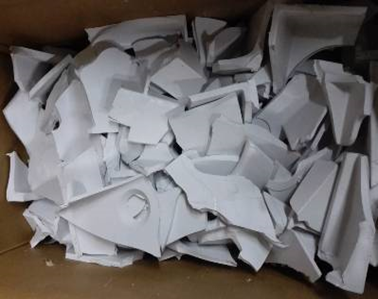The goal is to implement the circular economy concept in the polyurethane (PU) life cycle by incorporating a viable chemical recycling process to obtain new, high-quality products (green polyols) that can be used to manufacture new PU-based parts.
The project is being carried out at national level and involves three companies (Titan Recycling, Arcesso Dynamics and AMB Electrónica de Brescia) and two technology centres (Gaiker and AIMPLAS). It was launched in July 2018 and is due to end in July 2021.
PU waste has a variety of origins, since it is currently one of the most versatile polymers due to its countless forms, which range from rigid or flexible lightweight foams to resistant, rigid and strong elastomers. Because of PU’s wide variety of applications, PU waste is generated by a number of different industries, including construction and demolition, end-of-life vehicles, and electrical and electronic devices.
This project focuses on three main waste streams: a post-consumer PU waste stream from refrigerator insulation (WEEE), a stream from the furniture industry (flexible foam from mattresses) and a post-industrial stream for plastic parts that have been rejected during the manufacturing process (scrap, defective parts, etc.).
Currently, PU waste is subjected to mechanical recycling, which involves reducing it to pellets or powder for subsequent use as a filler or additive in other products. This treatment results in low-value materials. Because of this, current recycling rates are very low, at around 10%, and the majority ends up in landfill. For this reason, this project aims to examine the viability of chemical recycling through glycolysis, which consists of chemical depolymerization by breaking the polymer chains with chemical agents (including a solvent, generally in the presence of a catalyst) under specific, controlled reaction conditions. This process is used to obtain new, high-quality polyols that can be used to manufacture polyurethane again. Depending on the polyol obtained, different kinds of parts (rigid, flexible or foamed) can be manufactured.
Challenges and Innovative Aspects of Chemical Recycling of Polyurethane
Continuous progress has been made in the development of new technologies for recycling PU waste for more than a decade. In recent years, it has become a more pressing issue and a matter of priority for several reasons, including the closure of landfills, the high price of raw materials, increasingly stringent laws and greater social awareness of sustainable development and the circular economy. A number of initiatives seek to implement chemical recycling processes for PU waste in industry; however, these initiatives have been developed for clean waste, since they focus mainly on post-industrial waste such as scrap generated in manufacturing processes. However, most post-consumer waste is contaminated with other compounds and may be dangerous or incompatible with subsequent treatment and reuse processes, thereby limiting the amount of such waste that is treated by means of solvolysis.
Obtaining green polyols (eco-polyols) and green polyurethane (eco-polyurethane) involves converting current low-value recycling (downcycling) to high-value recycling (upcycling).
Currently, the chemical recycling of polyurethane is not a widespread practice and is not economically viable, especially in plants with a treatment capacity of more than 8,000 tonnes a year. To solve this problem, the goal of the FOAM2FOAM project is to build modular plants with a capacity of 2,000 tonnes a year and link several modules together.
Work Plan and Current Status of the Project
The project started in July 2018 and has a total duration of 36 months. Therefore, it has been under way for almost two years already. To achieve the project milestones, it has been divided into seven stages:
- Collection, classification and conditioning of PU waste.
- Laboratory-scale study: catalytic glycolysis in laboratory reactor
- Purity and quality of the recovered polyols.
- Scaling-up assessment (1:5, 1:50, 1:100) and pilot plant design.
- Construction of the pilot plant for solvolysis of PU waste.
- Manufacture of new PU parts from the recovered polyols.
- Monitoring and analysis of process sustainability.
Stage 2 is already complete and involved selecting the optimal conditions for glycolysis (solvents, catalysts, temperature and time) for each waste stream. Stage 3, which consists of classifying the recovered polyols and identifying the optimal purification process, is currently nearing completion. Optimal formulations are being designed for the introduction of these recovered green polyols into current polyurethane formulations.
In parallel, work has been carried out on stage 4, which consists of carrying out a scaling-up assessment (1:5, 1:50, 1:100) and designing the pilot plant. In fact, the construction of the pilot plant for solvolysis of PU waste is due for completion before the end of 2020, and next year the manufacture of new polyurethane products from green polyols is expected to be validated. These products will be used primarily in the thermal insulation sector.
Through this project, the circular economy concept will be incorporated into the PU life cycle with a view to moving towards a zero-landfill economy through the glycolysis process, which makes it possible to obtain new, high-quality products (green polyols) for use as raw materials in the manufacture of new PU-based parts. Such projects are essential, since a rise in the consumption of PU is expected in the next decade; demand will be driven by Asia, the Pacific, Eastern Europe and South America, all emerging markets. Therefore, the development of new recycling options to obtain a product with high added value is key to facilitating the transition from a linear to a circular model.
AIMPLAS is participating in this project and carrying out research on this topic to meet its commitment to environmental sustainability. As a result, companies in the sector will be able to integrate circular economy criteria into their business models and turn the legislative changes that affect them into opportunities to improve efficiency and profitability and reduce environmental impact. In this regard, AIMPLAS also carries out research in areas such as biodegradable materials and products, the use of biomass and CO2.










